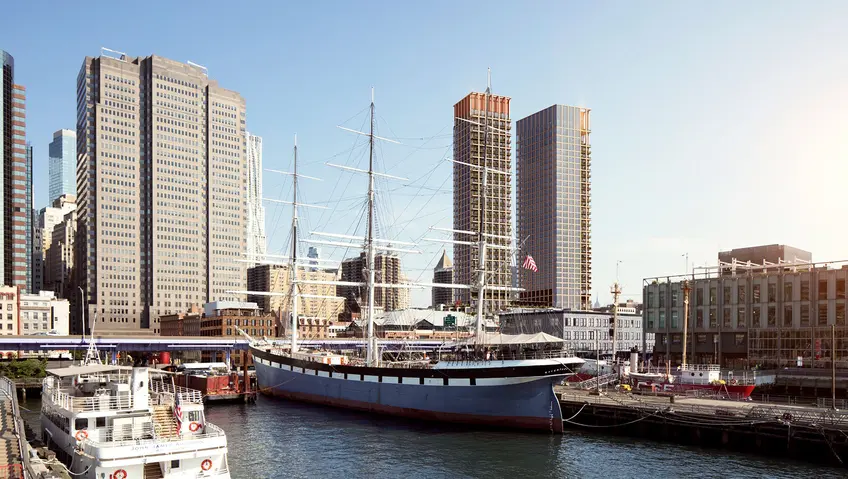 All images and renderings via Howard Hughes Corporation and SOM Architects for Landmarks Preservation Commission
All images and renderings via Howard Hughes Corporation and SOM Architects for Landmarks Preservation Commission
On Tuesday, January 5, Howard Hughes Corporation and Skidmore Owings & Merrill (SOM) appeared before the Landmarks Preservation Commission (“Landmarks”) to discuss their plans for a $1.4 billion mixed-use project at 250 Water Street, an empty lot in the South Street Seaport Historic District. The proposal calls for a two-tower development holding 360 new housing units - 100 affordable, 260 market-rate condos - new commercial space, new retail space, and new community space. The project would also provide a $50 million endowment to the South Street Seaport Museum, not to mention a new building for the museum at 89 South Street (currently another vacant lot on John and South streets).
Members of the public have been eager to weigh in online ever since Landmarks hearings moved online, but this particular hearing took the cake: Nearly 140 speakers signed up, and Landmarks received abundant written testimony. Even with a three-minute time limit, the hearing went on for hours. Due to the sheer volume, Landmarks intentionally decided not to take action on January 5. Instead, a public meeting will take place on Tuesday, January 12, after Landmarks has had the chance to absorb and consider all aspects. While we’re waiting, take this time to read up on the project.
In this article:
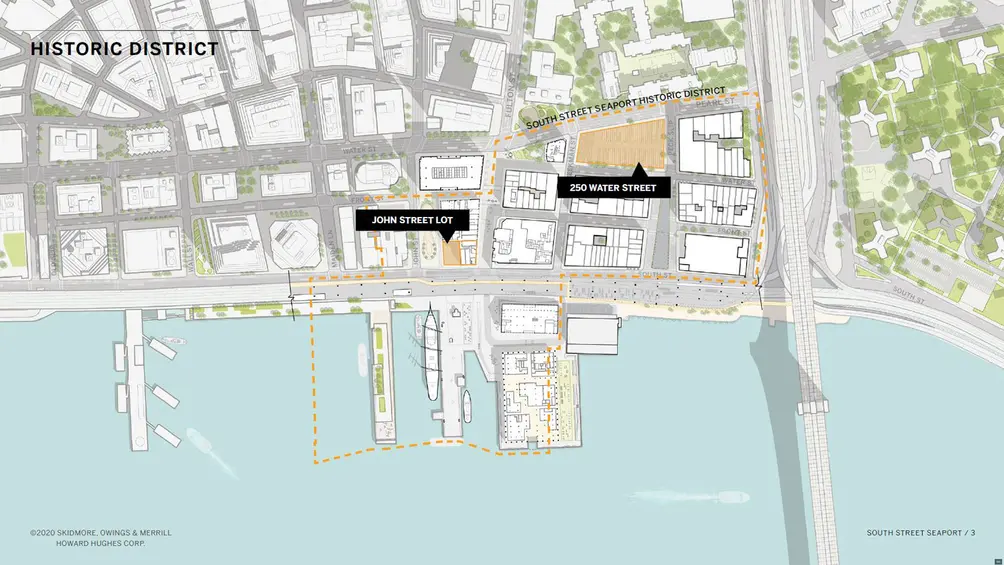
The proposed building features a six-story podium with a pair of 38-story residential towers on top
While a height of 470 feet sounds tiny compared to some of the supertalls that have risen in Manhattan in recent years (not to mention certain new condos in Lower Manhattan!), some consider it stratospheric for the South Street Seaport Historic District. The New York Landmarks Conservancy expressed fear that the towers would overwhelm the district. However, a former Landmarks chairman suggested that the new buildings would blend into the tall modern buildings immediately behind it. Renderings show that while the new buildings would certainly stand out, they would not be a jarring new addition to the Lower Manhattan skyline.
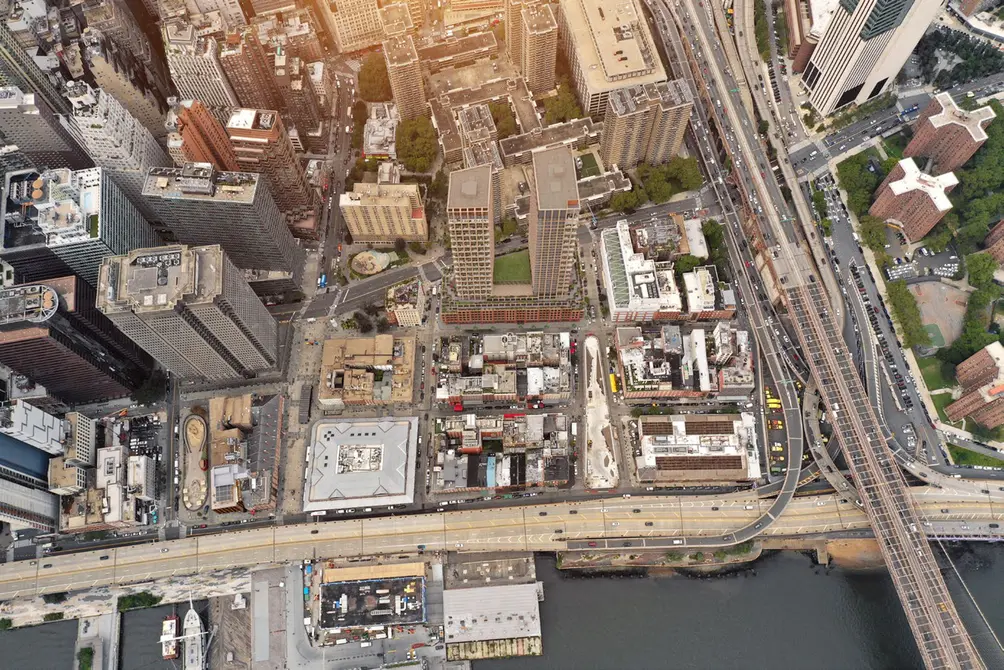
“This is not large by New York City standards [or] by Lower Manhattan standards” - Kenneth Jackson, Columbia University professor emeritus
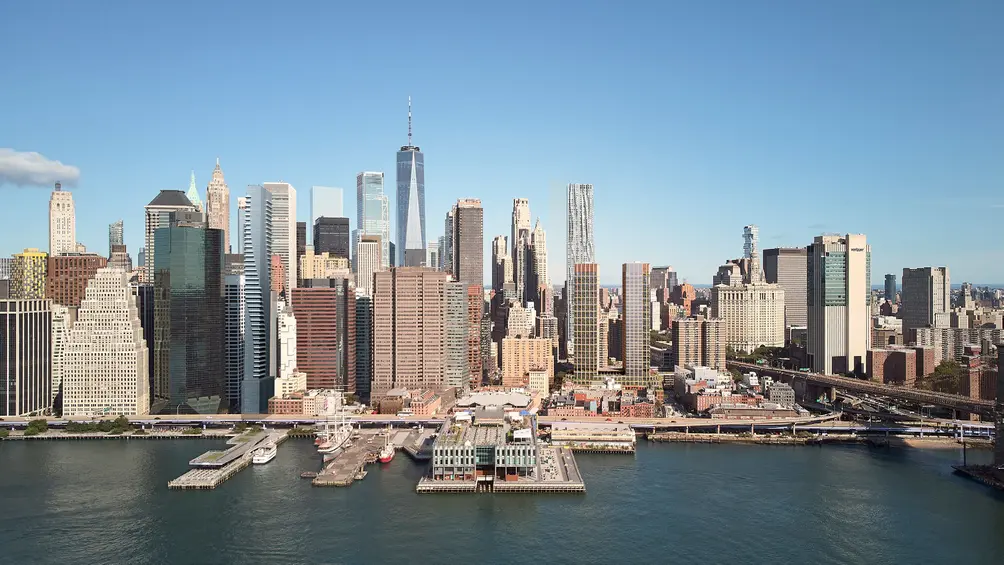
The development team describes the design as contextually sensitive
There is much ado about the pair of 38-story residential towers, but commentary on the six-story commercial podium at the base was decidedly more muted. Renderings by SOM show that the new building would be highly consistent with its neighbors at street level, and the presentation calls for congruous materials and designs. The presentation says that this will “complete the streetscape of the district,” and renderings showing bustling streetscapes lend credence to this argument.
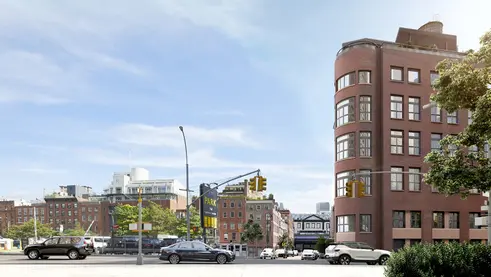
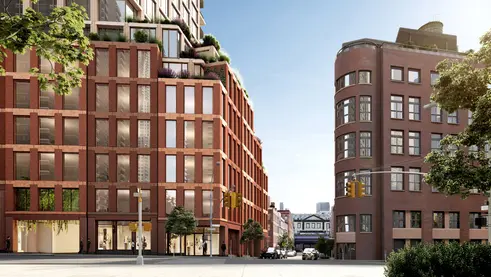
The project promised to bring up to 100 affordable housing units to the area
If 250 Water Street is approved, it will be the first affordable housing project to rise in the district under the Mandatory Inclusionary Housing program. It would bring as many as 100 affordable units to nearly double the local affordable housing stock - only 149 affordable housing units have been built in Community Board 1, home of the site, during the entire de Blasio administration.
While Landmarks will not make its decision based on the affordable units, the project’s proponents kept returning to them as a factor in their favorable opinion. If Landmarks approves it and it proceeds to land use review, The Real Deal notes that the affordable housing component will play a stronger role there.
While Landmarks will not make its decision based on the affordable units, the project’s proponents kept returning to them as a factor in their favorable opinion. If Landmarks approves it and it proceeds to land use review, The Real Deal notes that the affordable housing component will play a stronger role there.
The two 470'-tall towers feature fraternal facades but both prioritize private outdoor space
Renderings of the towers' residential levels show oversized windows and private balconies. The address allows for spectacular views of historic architecture, the East River, and the Brooklyn Bridge; additionally, a diagram included in the presentation shows plans to devote the entire eighth story to amenities. The building’s proximity to Lower Manhattan offices and schools, not to mention the Fulton Street transportation hub, makes it an appealing option to families. It is far too soon to know how much the market-rate condos would be priced at, but it is suggested that it could be high enough to accommodate rents targeted at those earning 40 percent of the Area Median Income ($31,840-$60,040).
The project would not only revitalize the South Street Seaport Museum, but possibly save it
The South Street Seaport Museum’s gallery spaces were flooded during Superstorm Sandy and remain closed today. In the short term, the developer's and museum's first priority would be to reopen the gallery, make much-needed restorations to the historic building, and move the entrance to the corner of South and Fulton Streets for greater visibility.
The second phase of the project would bring a new building to 89 John Street, which would connect to the historic structure and display artifacts. Renderings of the new museum show a building with a copper patina, shutters and arches consistent with its surroundings, and a congruous height. But the Historic Districts Council is unmoved, calling the new building “a Trojan horse with the hidden cost of irreparably damaging the historic district.”
The second phase of the project would bring a new building to 89 John Street, which would connect to the historic structure and display artifacts. Renderings of the new museum show a building with a copper patina, shutters and arches consistent with its surroundings, and a congruous height. But the Historic Districts Council is unmoved, calling the new building “a Trojan horse with the hidden cost of irreparably damaging the historic district.”
"Without the museum, there is no historic district." - Margaret Chin, New York City Council Member
The South Street Seaport Museum was founded in 1967, a full decade before the South Street Seaport Historic District was designated. Since then, it has served as a storyteller and interpreter of the historic district. The importance cannot be overstated, which is why the developer included the endowment.
While those testifying were asked to stick to key issues, the future of the museum kept coming up in remarks. The museum has struggled with financial concerns from the 9/11 attacks to the coronavirus pandemic, and the chairman of the museum’s board called the project a chance for financial stability. Even opponents of the project raised the suggestion that air rights in the district could be sold to raise money for the museum.
While those testifying were asked to stick to key issues, the future of the museum kept coming up in remarks. The museum has struggled with financial concerns from the 9/11 attacks to the coronavirus pandemic, and the chairman of the museum’s board called the project a chance for financial stability. Even opponents of the project raised the suggestion that air rights in the district could be sold to raise money for the museum.
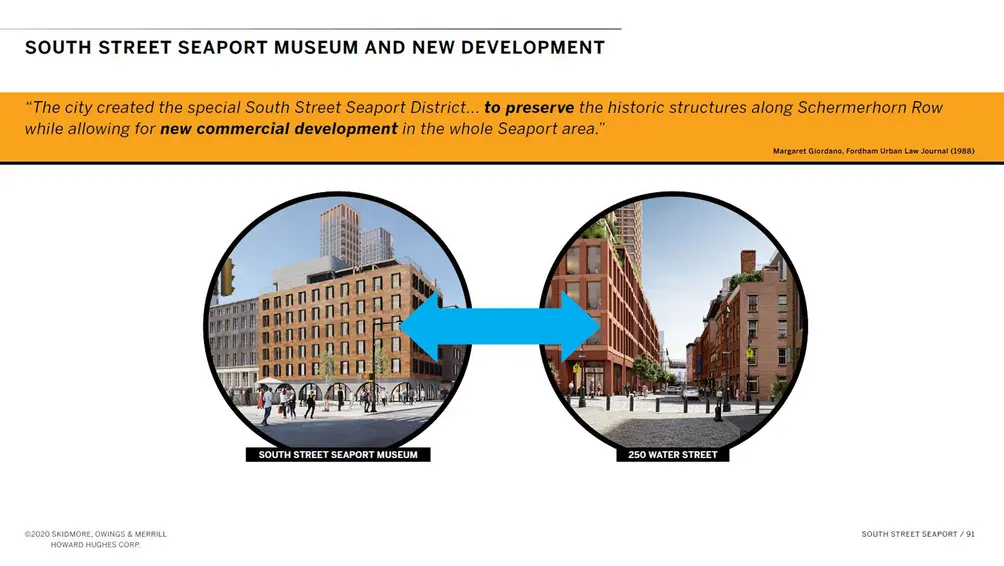
The project has attracted noteworthy supporters
Manhattan Borough President Gale Brewer is known for her opposition to outsize buildings, so it came as a surprise to The Real Deal when she spoke in favor of the project. Additional supporters include New York City Council Member Margaret Chin, Downtown Alliance president Jessica Lappin, Manhattan historian and retired Columbia architecture professor Kenneth Jackson, former Landmarks chairman Robert Tierney, and former Economic Development Corporation president Seth Pinsky.
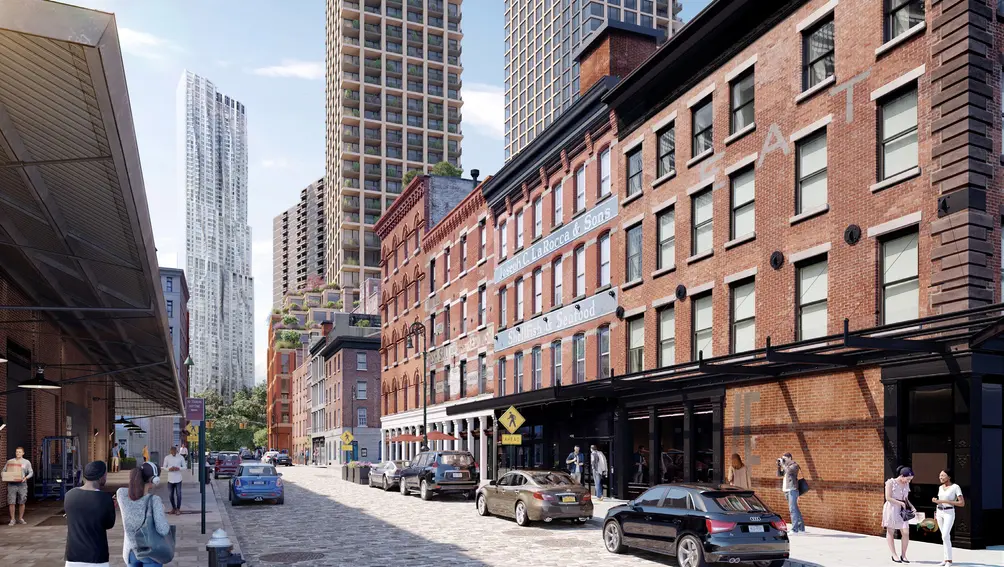
"It has been crafted to reflect the existing urban context...[and] will overall ensure the success of the district for years to come"
- Gale Brewer, Manhattan Borough President
There are environmental benefits to consider
The thermometer factories near the project's site may be gone, but their chemical remnants, mercury among them, leaked belowground. To that end, the Howard Hughes Corporation has applied for inclusion in the Brownfield Cleanup Program to remove the hazardous materials, and the cleanup would take place before the new construction. Moreover, the project promises to improve walkability, thus cutting down on the pollution caused by car traffic.
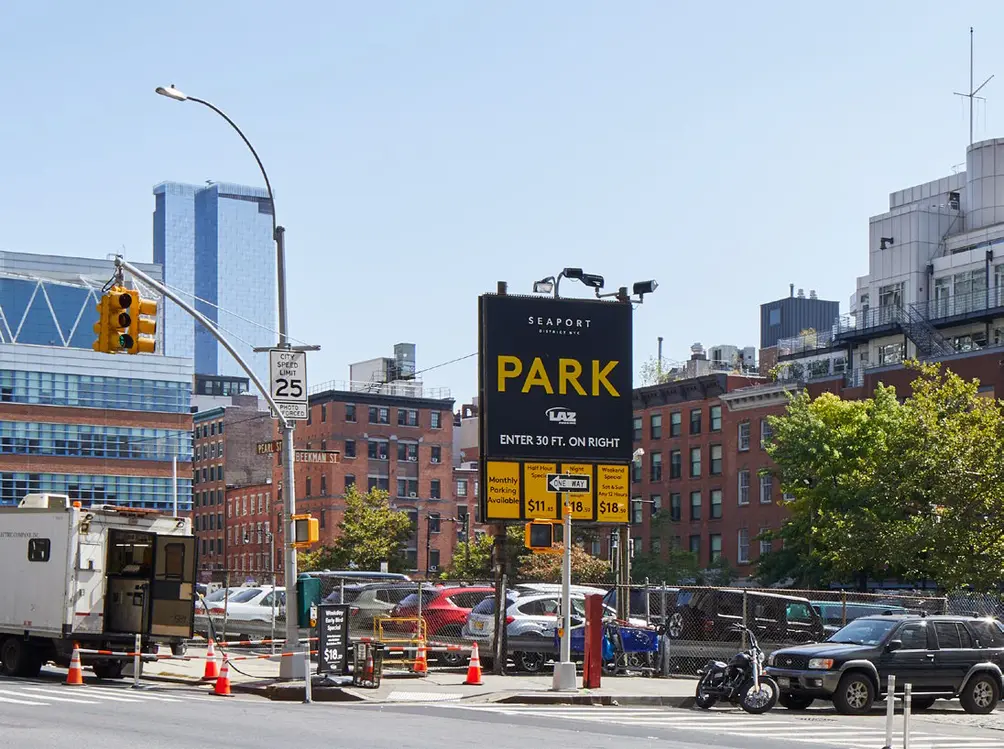 The existing lot at 250 Water Street
The existing lot at 250 Water Street
Air rights are at the core of this project
Once again, air rights play an outsize role in a New York development project. Development rights from the Tin Building and Pier 17, both of which are city-owned properties, would be transferred to 250 Water Street to allow the construction of the new building. That is not to say that it would happen immediately - if Landmarks approves this project, a lengthy public review process is sure to follow.
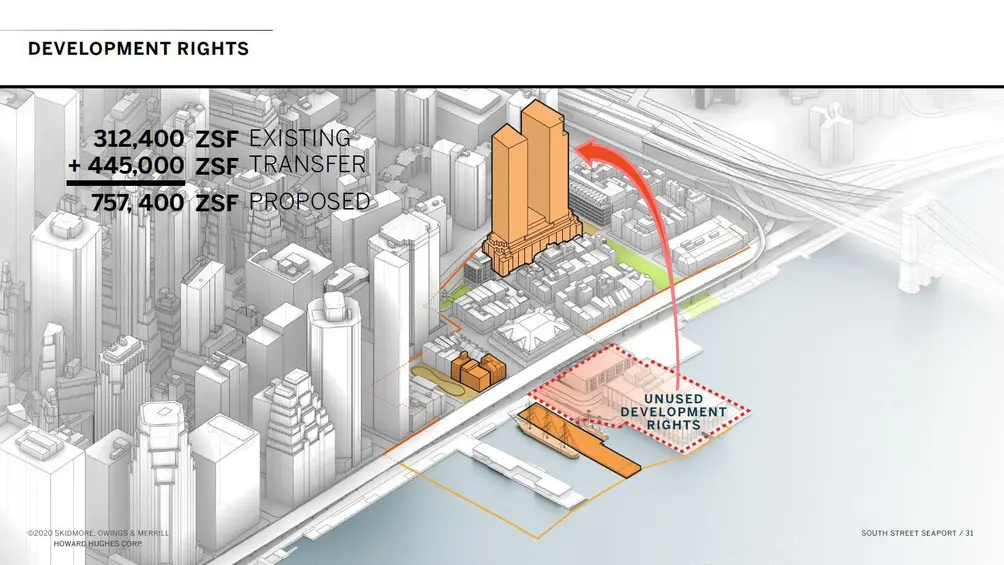
This is far from the first proposal for the site
Over the past 25 years, Landmarks has rejected nine different proposals for 250 Water Street. The closest the site ever came to development was in 1991, when an 11-story office building was approved for the site, but that project was never built. More recently, local residents, elected officials, and the South Street Seaport Museum soundly rejected the group’s original idea of a single tower measuring nearly 1,000 feet tall.
250 Water Street is the largest empty site in any of New York’s historic districts
“I’m like, ‘This is crazy.’ You’re defending a parking lot.” So said Sarah McNally, whose bookstore McNally Jackson has an outpost in the South Street Seaport, and she isn’t the only incredulous one. Some wonder why this empty site was included in the South Street Historic District in the first place; to answer that question, a 1989 report in The New York Times says it was included to detract from high-rise development that would block apartment views. Indeed, the developer has suggested that the project’s opponents seek to preserve their own views at the expense of the neighborhood.
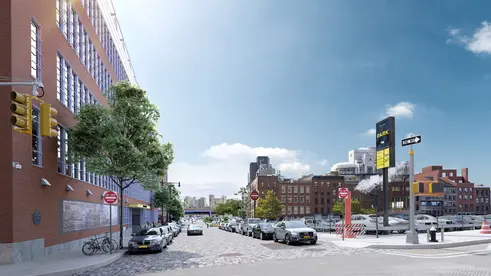
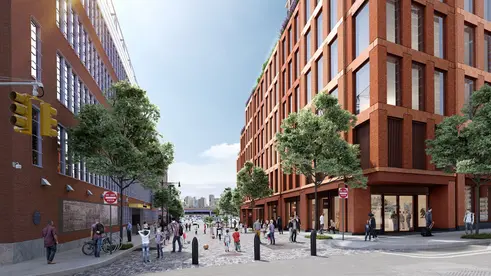
"Reject this corporate greed and protect one of our National Treasures" - Change.org petition opposing the project
If not this project...a tow pound?
According to Gothamist, more than 6,500 people have signed a petition against the towers. But lest they be accused of NIMBY-ism, a group of local activists calling themselves the Seaport Coalition has proposed an alternative: moving a NYPD tow pound downtown from its current Midtown location, building a low-scale garage on the site, and including an active recreation space. Between the specter of climate change and the steps New York is taking to become more pedestrian-friendly, the prospect of a car-oriented project has some scratching their heads.


 6sqft delivers the latest on real estate, architecture, and design, straight from New York City.
6sqft delivers the latest on real estate, architecture, and design, straight from New York City.
